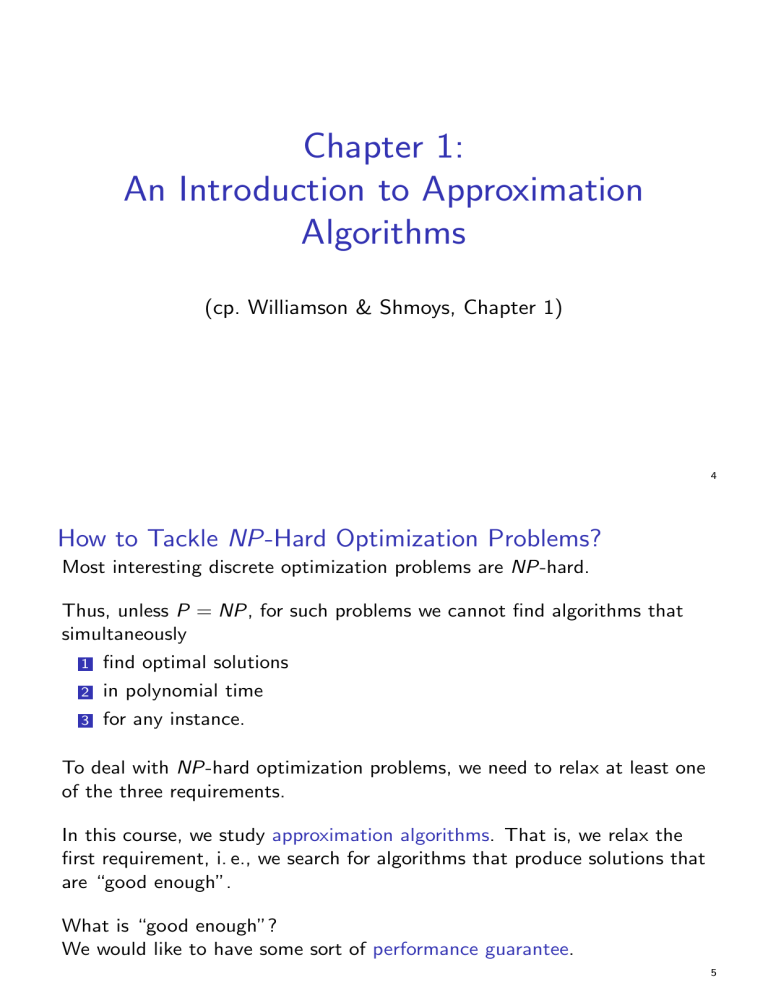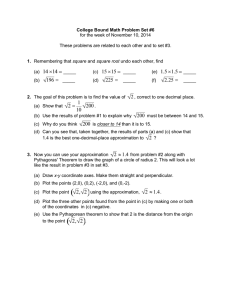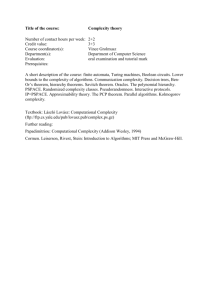
Chapter 1:
An Introduction to Approximation
Algorithms
(cp. Williamson & Shmoys, Chapter 1)
4
How to Tackle NP-Hard Optimization Problems?
Most interesting discrete optimization problems are NP-hard.
Thus, unless P = NP, for such problems we cannot find algorithms that
simultaneously
1
find optimal solutions
2
in polynomial time
3
for any instance.
To deal with NP-hard optimization problems, we need to relax at least one
of the three requirements.
In this course, we study approximation algorithms. That is, we relax the
first requirement, i. e., we search for algorithms that produce solutions that
are “good enough”.
What is “good enough”?
We would like to have some sort of performance guarantee.
5
Approximation Algorithms
Definition 1.1.
An α-approximation algorithm for an optimization problem is a
polynomial-time algorithm that for all instances of the problem produces a
solution whose value is within a factor of α of the optimum value.
For an α-approximation algorithm, we call α the performance guarantee
(or approximation ratio/factor) of the algorithm.
Convention:
I α > 1 for minimization problems, and
I α < 1 for maximization problems.
Thus, a 12 -approximation algorithm for a maximization problem is a
polynomial-time algorithm that always returns a solution whose value is at
least half the value of the optimum value.
Example:
Christofides’ algorithm is a 32 -approximation algorithm for the TSP.
6
Polynomial-Time Approximation Schemes
Remarks:
I
The worst-case bounds are often due to pathological cases that hardly
arise in practice.
I
Often, approximation algorithms are much better in practice than
indicated by their performance guarantee.
Definition 1.2.
A polynomial-time approximation scheme (PTAS) is a family of algorithms
{Aε }, where there is an algorithm for each ε > 0, such that Aε is a
I
(1 + ε)-approximation algorithm (for minimization problems), or a
I
(1 − ε)-approximation algorithm (for maximization problems).
Examples: PTASes exist for the Knapsack Problem and the Euclidean TSP.
7
Set Cover Problem
I
There are several fundamental techniques used in the design and
analysis of approximation algorithms.
I
In particular, linear programming plays an essential role!
I
In this introductory chapter, we illustrate some of the techniques on
the Set Cover Problem.
Set Cover Problem:
Given: A set of elements E = {e1 , . . . , en }, a family of subsets
{S1 , . . . , Sm } ⊆ 2E , and a weight wj ≥ 0 for each j ∈ {1, . . . , m}.
P
S
Task: Find I ⊆ {1, . . . , m} minimizing j∈I wj s.t. j∈I Sj = E .
If wj = 1 for each j ∈ {1, . . . , m}, the problem is called Unweighted Set
Cover Problem.
8
IP Formulation of Set Cover
Formulation as integer linear program:
∗
zIP
= min
m
P
wj · xj
j=1
s.t.
P
xj
≥
1
for all i = 1, . . . , n
xj
∈ {0, 1}
for all j = 1, . . . , m
(1.1)
j:ei ∈Sj
Linear programming relaxation:
∗
zLP
= min
m
P
wj · xj
j=1
s.t.
P
xj
≥ 1
for all i = 1, . . . , n
xj
≥ 0
for all j = 1, . . . , m
(1.2)
j:ei ∈Sj
Note: xj ≥ 0 suffices as xj ≤ 1 is redundant.
9
A Deterministic Rounding Algorithm
For each i = 1, . . . , n let fi := |{j | ei ∈ Sj }| be the number of sets
containing ei , and f := maxi=1,...,n fi .
Deterministic Rounding Algorithm for Set Cover:
1 Compute an optimal solution x ∗ to the set-cover-LP (1.2).
2
For each j ∈ {1, . . . , m}, set x̂j = 1 if xj∗ ≥ f1 , and x̂j = 0 otherwise.
Lemma 1.3.
The collection of subsets Sj with j ∈ Î := {j | x̂j = 1} is a set cover.
Proof: . . .
Theorem 1.4.
The rounding algorithm above is an f -approximation algorithm for the Set
Cover Problem.
Proof: . . .
Note: The algorithm is a 2-approximation for the Vertex Cover Problem.
10
Dual Linear Program
Linear programming relaxation:
∗
zLP
= min
m
P
wj · xj
j=1
P
s.t.
xj
≥ 1
for all i = 1, . . . , n
xj
≥ 0
for all j = 1, . . . , m
j:ei ∈Sj
Dual linear program:
∗
zLP
= max
n
P
yi
i=1
s.t.
P
yi
≤ wj
for all j = 1, . . . , m
yi
≥
for all i = 1, . . . , n
(1.3)
ei ∈Sj
0
11
Rounding a Dual Solution
Dual Rounding Algorithm for Set Cover:
1
2
compute an optimal solution y ∗ to the dual (1.3) of the set-cover-LP;
P
let I ∗ := {j | i:ei ∈Sj yi = wj };
Lemma 1.5.
The collection of subsets Sj with j ∈ I ∗ is a set cover.
Proof: . . .
Theorem 1.6.
The dual rounding algorithm is an f -approximation algorithm for the Set
Cover Problem.
Proof: . . .
Remark: Notice that I ∗ ⊇ Î due to complementary slackness!
12
Primal-Dual Algorithm
Note: The two previous algorithms require solving a linear program.
Special purpose algorithms are often much faster!
Idea: Construct a feasible dual solution that is “good enough”.
Primal-dual algorithm for the Set Cover Problem:
1
2
3
set y :≡ 0 and I := ∅;
S
while ∃ek 6∈ j∈I Sj
P
increase yk until ∃j with ek ∈ Sj such that
yi = wj ;
i:ei ∈Sj
4
set I := I ∪ {j};
Theorem 1.7.
The primal-dual algorithm is an f -approximation algorithm for the Set
Cover Problem.
Proof: As before.
13
Greedy Algorithm
Idea: Iteratively select a set minimizing the ratio of its weight to the
number of currently uncovered elements it contains.
Greedy algorithm for the Set Cover Problem
1 set I := ∅ and Ŝj := Sj for all j;
2
3
while I is not a cover
n
o
wj
| Ŝj 6= ∅ ;
` := argmin
|Ŝj |
4
set I := I ∪ {`};
5
set Ŝj := Ŝj \ S` for all j;
Theorem 1.8.
∗ , where
The greedy algorithm returns
I with w (I ) ≤ Hg · zLP
Pg a cover
g := maxj |Sj | and Hg := k=1 k1 ≈ ln g .
Proof: Use technique called dual fitting. . .
14
Nonapproximability Results for Set Cover
Theorem 1.9 (Lund & Yannakakis 1994, ).
If there is a c ln n-approximation algorithm for the Unweighted Set Cover
Problem for some constant c < 1, then there is an O(nO(log log n) )-time
deterministic algorithm for each NP-complete problem.
Theorem 1.10 (Feige 1998).
There is some constant c > 0 such that if there is a c ln n-approximation
algorithm for the Unweighted Set Cover Problem, then P = NP.
Theorem 1.11 (Dinur & Safra 2002).
If there is an√α-approximation algorithm for the Vertex Cover Problem
with α < 10 5 − 21 ≈ 1.36, then P = NP.
Theorem 1.12 (Khot & Regev 2008).
Assuming the Unique Games Conjecture holds, if there is an α-approximation algorithm for the Vertex Cover Problem with α < 2, then P = NP.
15


